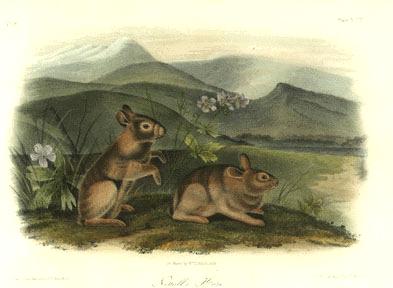

94 Nuttall's Hare
LEPUS NUTTALII.--Bachman.
[Sylvilagus Nuttallii]
NUTTAL'S HARE.
[Nuttall's Cottontail]
PLATE XCIV.--MALES.
L. parvus, supra fuscus cum aureo mistus subtus dilute flavo-canescens
auriculis amplis rotundatisque, cauda longiuscula, subtus albus.
CHARACTERS.
Small; tail of moderate length, general colour above, a mixture of light
buff and dark brown, beneath, light yellowish grey; ears, broad and rounded;
lower surface of the tail white.
DESCRIPTION.
The anterior upper incisors are more rounded than those of the American
Hare, but in the deep longitudinal furrows, and in other particulars they bear a
striking resemblance to those of that species; the accessory, upper incisors
resemble those of the Hares in general. The lower incisors are rather thinner
than those of the American Hare, and like the upper, more of an oval shape. The
upper grinders are furrowed longitudinally, like those of other Hares, and have
a slight furrow on the inner side, but not more apparent than in Lepus
aquaticus; indeed, all the American Hares have this furrow, which differs
considerably in individuals belonging to the same species.
This Hare bears some resemblance to the young of Lepus sylvaticus; the
forehead is more arched, and there is no depression in the frontal bone, as in
the American Hare; its fur is also much softer, and differs in colour; the
whiskers are nearly the length of the head. The ears appeared rather short and
shrivelled in the dried specimen, but when moistened for the purpose of having a
drawing of them made became much distended; the incurvation on their outer
margin was as distinct as in other Hares, bearing no resemblance to the
funnel-shaped ears of the pika. The tail in the living animal must be
conspicuous, although in the dried specimen it is concealed by the long fur of
the posteriors. The feet are thickly clothed with soft hair, completely
covering the nails. There are five toes on the fore and four on the hind feet.
COLOUR.
Teeth, yellowish white; whiskers, white and black; the former colour
predominating; the whole of the upper surface of the body, a mixture of buff and
dark brown; under surface light buff-grey. The fur on the back is, for
three-fourths of its length from the roots, plumbeous, then light ash mixed with
buff; and the long interspersed hairs are all tipped with black. The ears are
pretty well clothed, internally and externally, with hairs of an ash colour,
bordered with a line of black anteriorly, and edged with white. From behind the
ears to the back, there is a very broad patch of buff, and the same colour,
mixed with rufus, prevails on the outer surface of the legs, extending to the
thighs and shoulders. The soles of the feet are yellowish brown. The claws,
which are slightly arched, are light brown for three-fourths of their length,
and are tipped with white; under surface of the tail, white.
DIMENSIONS.
Inches.
Length from point of nose to insertion of tail,. . . 6 1/4
Length of Heel, . . . . . . . . . . . . . 2
Length of Fur on the back,. . . . . . . . . . 3/4
Length of Head, . . . . . . . . . . . . . 2 1/8
Height of ear,. . . . . . . . . . . . . . 1 1/2
Tail vertebrae, . . . . . . . . . . . . . 3/4
Including fur,. . . . . . . . . . . . . . 1 1/4
HABITS.
The only information which we have been able to obtain of the habits of
this diminutive species is contained in the following note from Mr. NUTTAL,
which accompanied the specimen.
"This little Hare we met with west of the Rocky Mountains, inhabiting
thickets by the banks of several small streams which flow into the Shoshonee and
Columbia rivers. It was frequently seen, in the evening, about our encampment,
and appeared to possess all the habits of the Lepus Sylvaticus."
GEOGRAPHICAL DISTRIBUTION.
We have not heard of the existence of this Hare in any part of California,
or New Mexico; and although it is doubtless found in other localities than those
mentioned above, we cannot venture to assert that it is widely distributed
GENERAL REMARKS.
We described this species from the only specimen we have had an opportunity
of examining. It would be satisfactory to be able to investigate further, as it
needs more information than we have been able to obtain, to pronounce decidedly
upon its characters, and give its true geographical distribution.
|